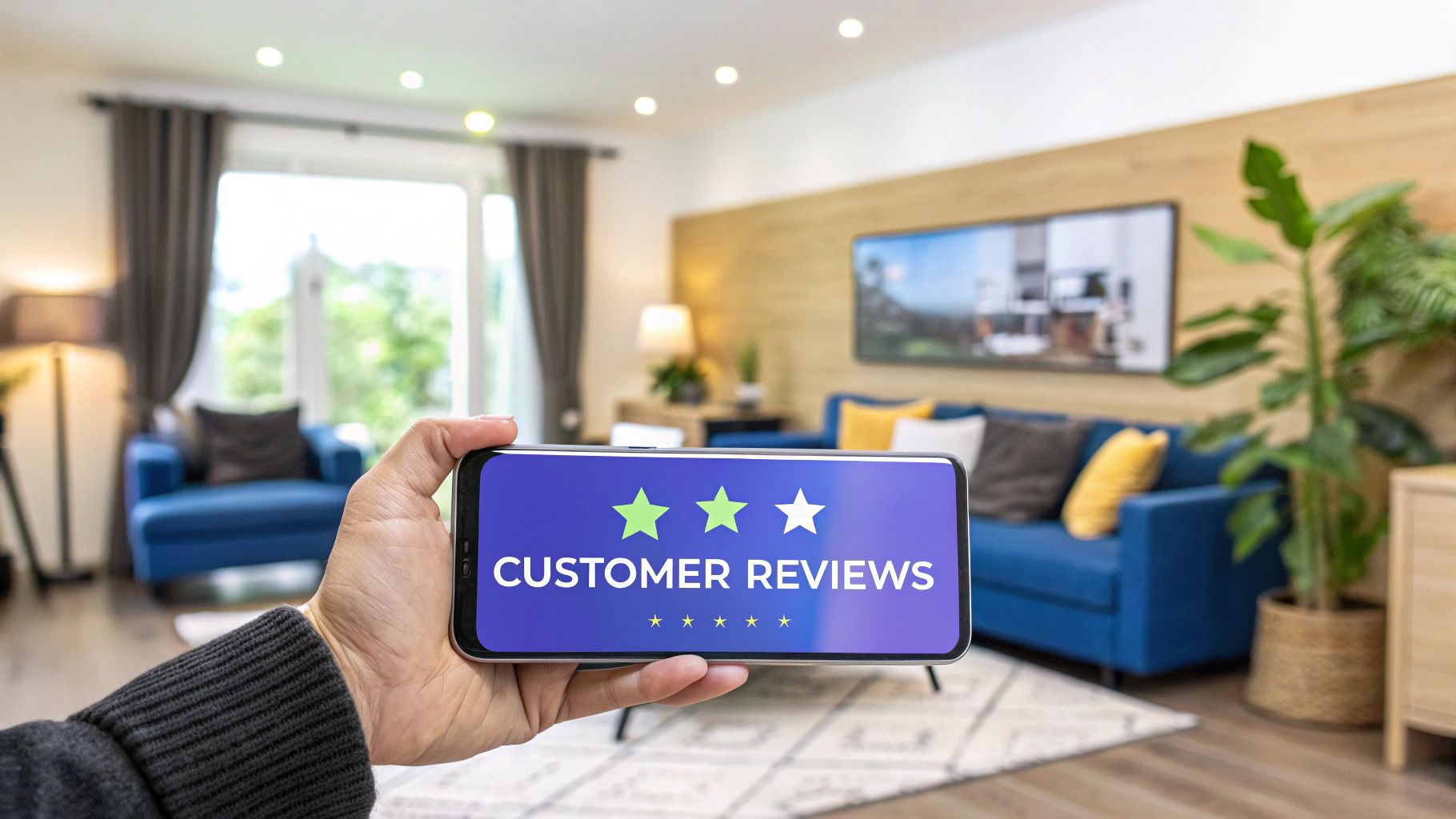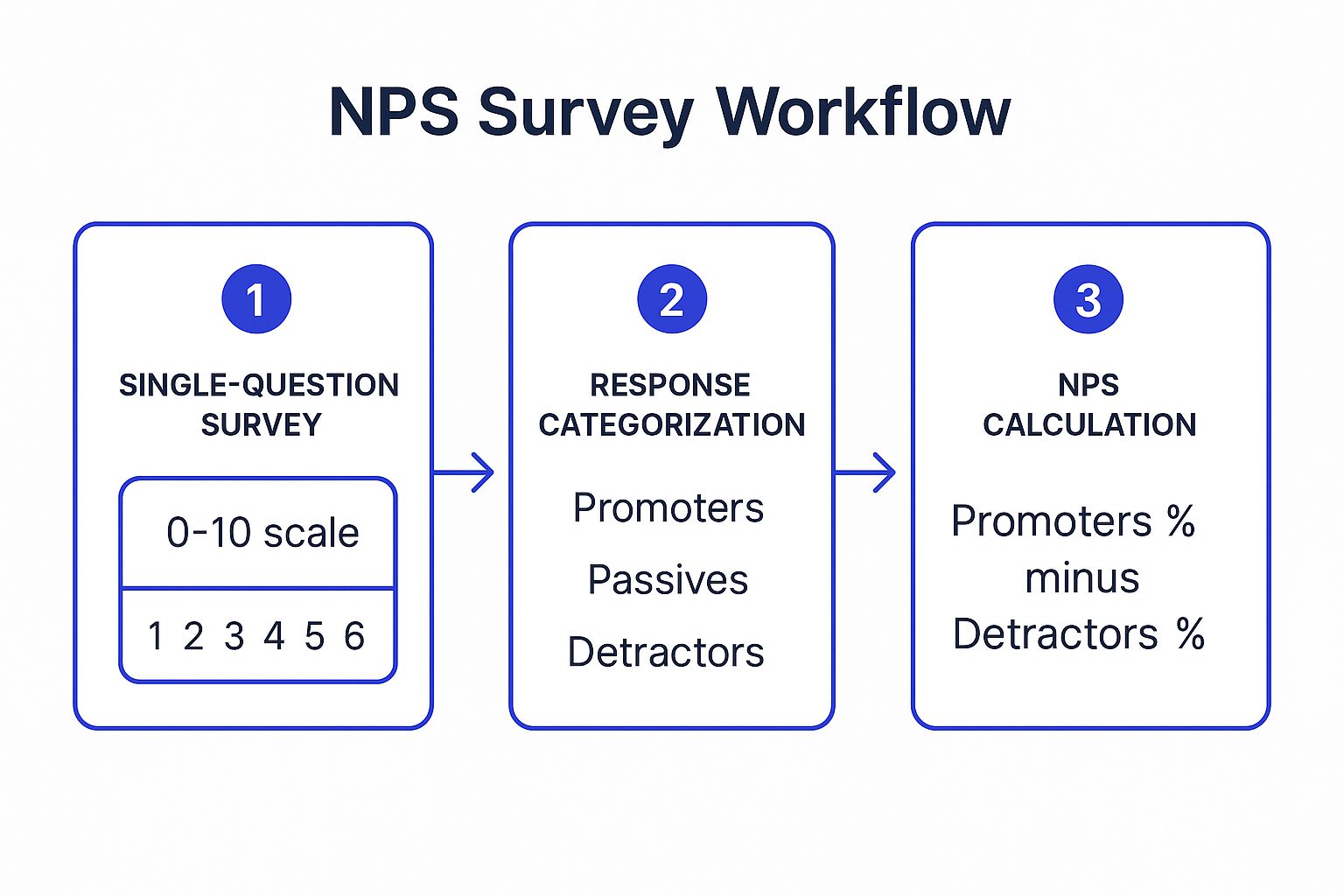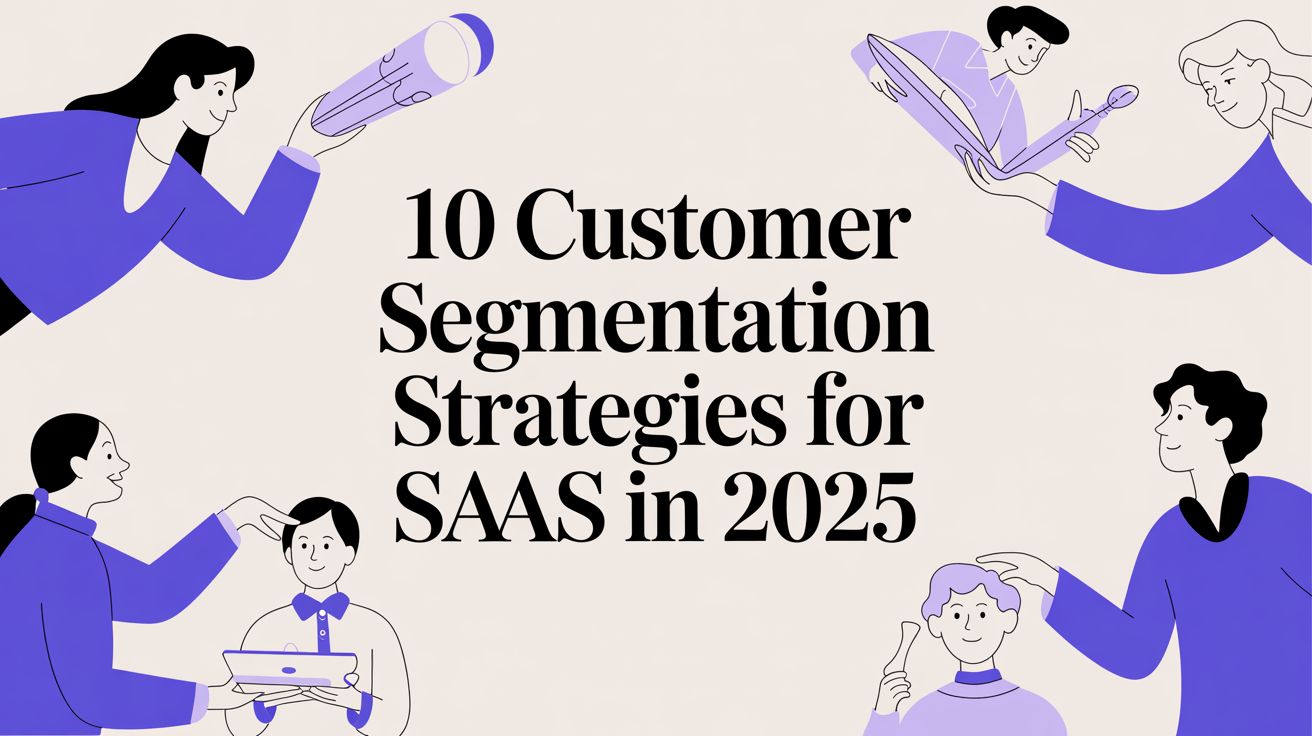Voice of the Customer Examples: Boost Your Product Insights
Explore top voice of the customer examples from Amazon, Tesla, and more. Learn how SaaS teams can leverage these strategies to enhance their products.

Knowing what your customers think is fundamental to building a product they will love and pay for. It's about turning customer comments, complaints, and compliments into your next big feature or a better user experience. This direct line to customer perception is at the core of any successful Voice of the Customer (VoC) program. A strong VoC strategy reduces churn, fuels innovation, and drives sustainable growth by aligning your roadmap with what users actually want.
This article explores seven powerful voice of the customer examples from companies that mastered this process, including Amazon, Slack, and Tesla. We will break down precisely how they gather and act on customer input, providing a clear roadmap for putting your customers at the center of your business decisions.
You will learn specific, replicable strategies for:
- Designing effective feedback collection systems.
- Analyzing qualitative and quantitative data.
- Translating customer insights into concrete product improvements.
From simple surveys to complex, integrated feedback loops, these examples provide a blueprint for how your SaaS team can apply the same principles, regardless of your company's size or stage.
1. Amazon's Customer Reviews and Ratings System
Amazon’s customer review and rating system is one of the most recognizable and powerful voice of the customer examples in e-commerce. It's a massive, passive data collection engine that aggregates millions of customer opinions through star ratings, written reviews, photos, videos, and Q&As. This system directly influences purchasing decisions and serves as a direct line of communication from the user to both the seller and Amazon itself.

The platform operationalizes this feedback at an incredible scale. For instance, recurring safety concerns mentioned in reviews can trigger internal investigations, which can lead to product recalls. Similarly, widespread dissatisfaction with a product's quality, reflected in low ratings, can impact its search ranking or even lead to its removal from the marketplace. This direct link from customer voice to platform action is what makes it a benchmark for VoC programs.
Strategic Analysis
Amazon’s system succeeds because it creates a flywheel effect. More reviews attract more buyers, who then leave more reviews, which provides more data. The "Verified Purchase" tag is a key trust signal, separating genuine buyers from unverified commentators and adding credibility to the feedback.
This system is not just for buyers. It is a core component of Amazon's marketplace quality control. It provides a constant stream of performance data on third-party sellers, helping Amazon monitor the health of its ecosystem without direct, manual intervention for every transaction.
How to Adapt This for Your SaaS Business
While you might not have millions of users, the principles behind Amazon's success are highly adaptable for SaaS teams. Your goal is to create a transparent, accessible, and integrated feedback loop.
Actionable Takeaways:
- Implement In-App Ratings: Use simple, low-friction rating systems (like stars or smiley faces) after a user completes a key action or a new feature is used for the first time.
- Build a Public Feedback Board: Create a space where users can submit feature requests, upvote others' ideas, and see what's on your roadmap. Tools like Canny or Pendo Feedback can facilitate this.
- Tag and Analyze Qualitative Feedback: Do not just collect feedback; categorize it. Use tags like "bug," "feature_request," or "UX_friction" to quantify qualitative comments and identify trends. This turns anecdotal evidence into actionable data for your product and engineering teams.
2. Net Promoter Score (NPS) Surveys
The Net Promoter Score (NPS) is a widely adopted voice of the customer example focused on measuring customer loyalty. It simplifies customer sentiment to a single, powerful question: "On a scale of 0-10, how likely are you to recommend our company/product/service to a friend or colleague?" This simplicity makes it a low-friction method to capture high-level satisfaction and track trends over time.
Based on their response, customers are grouped into three categories: Promoters (score 9-10), Passives (score 7-8), and Detractors (score 0-6). The final NPS score is calculated by subtracting the percentage of Detractors from the percentage of Promoters. Companies like Tesla and Southwest Airlines famously use NPS to gauge customer sentiment, correlating high scores with strong organic growth and brand advocacy.
The following infographic illustrates the standard workflow for collecting and calculating an NPS score.

This process shows how the raw 0-10 rating is transformed into a clear metric representing overall customer loyalty.
Strategic Analysis
The power of NPS is not in the score itself, but in the "why" behind it. The real value is unlocked with the follow-up open-ended question, such as "What is the primary reason for your score?" This qualitative feedback provides the context needed to find out what drives loyalty or creates dissatisfaction, turning a simple metric into a source of actionable insights.
Strategically, NPS serves as a health metric for the customer relationship. It is most effective when tracked consistently over time, allowing teams to see how product updates, policy changes, or service improvements impact customer perception. Segmenting NPS results by user persona, plan type, or customer lifecycle stage further amplifies its strategic value.
How to Adapt This for Your SaaS Business
For a SaaS business, NPS is an efficient tool to take a regular pulse of your user base without causing survey fatigue. It provides a benchmark to measure the impact of your product and customer success efforts. To learn more, see this detailed guide on NPS surveys.
Actionable Takeaways:
- Time Your Surveys: Trigger NPS surveys after key moments in the customer journey, such as after onboarding is complete or following a significant interaction with customer support. This provides context-specific feedback.
- Always Ask "Why?": Never run an NPS survey without a qualitative follow-up question. The verbatim responses from your Promoters and Detractors contain the most valuable information for your product and marketing teams.
- Close the Loop: Create a process for following up with respondents, especially Detractors. Reaching out to find out about their issues and offering a solution can turn a negative experience into a positive one and reduce churn.
3. Starbucks Customer Feedback through My Starbucks Idea Platform
Starbucks' "My Starbucks Idea" platform was a pioneering example of large-scale, community-driven voice of the customer (VoC) feedback. It was a dedicated crowdsourcing website where customers could submit ideas for new products, store improvements, and social initiatives. Other users could then vote on, discuss, and build upon these suggestions, creating a direct and transparent innovation pipeline.

This initiative went beyond a simple suggestion box. The platform successfully channeled customer creativity into tangible business outcomes. For example, popular menu items like cake pops, mobile payment options, and the expansion of free in-store Wi-Fi all originated from customer submissions on the site. By publicly tracking ideas from submission to implementation, Starbucks made customers feel like valued partners in the brand's evolution.
Strategic Analysis
The genius of My Starbucks Idea was its ability to build a sense of community and co-creation. It gamified the feedback process with points and leaderboards, encouraging active participation. More importantly, it made the feedback process public, allowing Starbucks to visibly demonstrate that it was listening.
This transparency built significant brand loyalty. Customers could see their collective voice shaping the company's direction, which is a powerful retention tool. The platform also served as a rich source of qualitative data, revealing unmet needs and emerging trends that traditional surveys might miss. It was one of the most effective voice of the customer examples of its time for turning a brand into a collaborative project.
How to Adapt This for Your SaaS Business
While you may not have Starbucks' global customer base, creating a dedicated space for idea submission and community voting is highly effective for SaaS. The core goal is to centralize feedback and make your product development process more transparent and customer-centric.
Actionable Takeaways:
- Launch a Public Idea Board: Use tools like Canny, Pendo Feedback, or a dedicated community forum to create a space for feature requests. Allow users to submit their own ideas and upvote suggestions from others.
- Create a "Status" Loop: Do not let ideas sit in a black box. Implement a clear status system for submissions, such as "Under Review," "Planned," and "Shipped." This shows users their feedback is being actively considered.
- Reward Top Contributors: Acknowledge and reward users whose ideas make it onto your roadmap. This can be as simple as a personal thank-you email from the product manager, a small credit to their account, or a shout-out in your newsletter. This reinforces the value of their contribution.
4. Airbnb Post-Stay Review System
Airbnb's bilateral review system is a cornerstone of its marketplace, creating a powerful voice of the customer program built on mutual accountability. After a stay, both the guest and the host are prompted to review each other within a 14-day window. The reviews remain hidden until both parties have submitted their feedback, or until the window closes. This design encourages honest, unfiltered feedback on everything from cleanliness and communication to location accuracy and overall value.
The platform converts this qualitative feedback into structured data points that directly influence the ecosystem. For instance, consistently low ratings on cleanliness can trigger warnings for a host or lead to a temporary suspension of their listing. Conversely, consistently high ratings contribute to a host's "Superhost" status, a badge that builds trust and drives more bookings. This immediate connection between customer voice and marketplace consequence makes it a prime example of an operationalized VoC strategy.
Strategic Analysis
The genius of Airbnb’s system is its double-blind, reciprocal nature. This structure minimizes retaliatory or biased reviews, as neither party can see the other's feedback before submitting their own. It builds a level of trust and transparency that is vital for a platform facilitating interactions between strangers.
This system also serves as a behavioral guide. It implicitly teaches both hosts and guests what is expected of them. A guest who reads reviews praising a host's quick communication learns that responsiveness is valued. A host who sees a review mentioning a missing kitchen utensil learns what details matter to guests. It’s a self-correcting loop that continuously elevates the standard of the entire community.
How to Adapt This for Your SaaS Business
While you may not be managing a two-sided marketplace, the principle of mutual feedback and setting clear expectations is highly applicable for SaaS businesses, especially those with client-facing roles like customer success or support.
Actionable Takeaways:
- Implement Two-Way Feedback: After a support ticket is resolved or a customer onboarding is complete, survey both the customer and your internal team member. This gives you a 360-degree view of the interaction, highlighting both customer satisfaction and internal process friction.
- Create "Superuser" Programs: Identify and reward your most engaged and helpful users, similar to Airbnb's Superhost status. This could involve beta access, special badges in a community forum, or direct lines to your product team, incentivizing positive engagement.
- Analyze Feedback for Training: Systematically analyze customer feedback related to support or success interactions. Use common themes and a few well-crafted customer feedback survey questions to develop training materials that directly address areas where your team can improve its service delivery.
5. Tesla Customer Feedback Integration and Over-the-Air Updates
Tesla has redefined automotive customer feedback by creating a direct and rapid link between customer voice and product evolution. Instead of waiting for yearly model changes, Tesla integrates customer suggestions and complaints directly into software updates delivered over-the-air (OTA). This forms a continuous improvement loop where the customer’s experience actively shapes the vehicle's functionality long after the initial purchase.

This model treats the car like a software product, constantly iterating based on user input. For example, the popular "Dog Mode" feature, which maintains a safe cabin temperature for pets, was developed after a direct request from a user on Twitter. Similarly, "Sentry Mode" was created to address security concerns, while autopilot improvements are deployed based on massive amounts of real-world usage data and feedback. This direct responsiveness is a powerful voice of the customer example that builds immense brand loyalty.
Strategic Analysis
Tesla's VoC strategy is successful because it is visibly responsive. Customers see their suggestions turn into tangible features, which makes them feel heard and valued. This system transforms customer feedback from a passive data point into an active component of the company’s R&D process. The public nature of many requests, often handled via Elon Musk's Twitter account, adds a layer of transparency and accountability.
The OTA update mechanism is the key infrastructure that makes this possible. It allows the company to bypass the slow, physical recall-and-repair cycle typical of the auto industry. Instead, Tesla can deploy fixes, improvements, and new features to its entire fleet almost instantly, turning a potential logistical nightmare into a competitive advantage.
How to Adapt This for Your SaaS Business
Your SaaS platform is already built for rapid updates, giving you a head start in replicating Tesla's model. The key is to create a tight, transparent, and fast feedback-to-deployment cycle that users can see and appreciate.
Actionable Takeaways:
- Establish Direct Feedback Channels: Use tools like a public roadmap, an in-app idea portal, or even a dedicated community forum where users can submit and vote on feature ideas. Make these channels visible and easy to access.
- Communicate the "Why" Behind Updates: When you release a new feature or fix that came from customer feedback, celebrate it. Use your release notes and announcements to explicitly state, "You asked, we listened. Based on your feedback, we've added X."
- Use Data to Validate Qualitative Feedback: Combine direct user requests with product analytics. If users are asking for a shortcut for a specific workflow, check your data to see how many people are performing that multi-step action. This helps prioritize updates that will have the biggest impact.
6. Slack Customer Success and Product Feedback Loop
Slack’s product development process is a premier example of building a voice of the customer program directly into a company’s operational DNA. From its early days, Slack gathered intensive customer feedback through multiple, interconnected channels like in-app commands, dedicated customer success teams, user research sessions, and active community forums. This multi-pronged approach created a constant flow of insights that directly shaped its rapid growth and product-market fit.
The company is famous for acting on this feedback to refine its core experience. For example, insights from large enterprise clients led directly to the development of robust security features and compliance tools, which were critical for moving upmarket. Similarly, constant user requests for specific app integrations guided the expansion of its marketplace, turning Slack into a central work hub rather than just a messaging app.
Strategic Analysis
Slack's success with VoC comes from its ability to connect qualitative feedback with quantitative usage data. The company does not just listen to what users say; it observes what they do. This combination allows product teams to validate feature requests against actual behavior, making sure they build solutions for real, widespread problems.
The key is the tight integration between customer-facing teams (Support, Customer Success) and the product development team. Feedback is not logged into a forgotten database. Instead, it is actively triaged, categorized, and funneled to the right product managers, creating a responsive development cycle. This system makes customers feel heard and directly invested in the product's evolution. Learn more about how to build these kinds of systems by reading about feedback loop examples.
How to Adapt This for Your SaaS Business
Your goal is to create a culture where customer feedback is not just collected but is actively discussed and integrated into your sprint planning and roadmap decisions. This requires building systems to connect customer-facing teams with your product organization.
Actionable Takeaways:
- Establish Direct Feedback Channels: Create dedicated Slack or Teams channels (e.g., #feedback-product, #voice-of-customer) where support and success teams can post real-time customer insights, tag relevant product managers, and discuss trends.
- Segment Feedback by Customer Profile: Do not treat all feedback equally. Tag insights based on customer size (SMB vs. Enterprise), plan type (Free vs. Paid), or user persona. This helps prioritize features that impact your most valuable customer segments.
- Hold Regular VoC Syncs: Schedule bi-weekly or monthly meetings between product, engineering, and customer success leaders. Use this time to review top feedback themes, analyze related usage data, and make concrete decisions about what to investigate or build next.
7. Zappos Customer Service and Experience Feedback
Zappos built its brand not on selling shoes, but on delivering a "WOW" customer experience. Their voice of the customer program is less about formal surveys and more about using direct, human-to-human interactions as a primary source of feedback. They famously permit their customer service team to do whatever it takes to make a customer happy, turning service calls into rich, qualitative research opportunities.
This approach is best illustrated by legendary stories: a customer service call that lasted over 10 hours, surprise upgrades to overnight shipping, and sending flowers to a customer dealing with a personal tragedy. These actions are not just stunts; they are the result of a system designed to capture the unstated needs and emotional state of the customer. The feedback gathered from these personal, high-touch interactions informs everything from employee training to logistics and operational improvements.
Strategic Analysis
The Zappos model treats every customer interaction as a potential source of great insight. Instead of simply solving a transactional problem, their service agents are trained to listen for the "why" behind a customer's call. This turns the customer service department from a cost center into a powerful market research and brand-building engine.
The strategy's success depends on extreme employee latitude. By removing strict scripts and time limits, Zappos allows for genuine conversations to unfold. This provides a constant stream of unfiltered, emotionally rich feedback that typical surveys or analytics platforms could never capture. This is one of the most powerful voice of the customer examples for companies focused on a service-led growth model.
How to Adapt This for Your SaaS Business
While not every SaaS company can afford 10-hour support calls, the core principle of using service interactions for research is highly applicable. The goal is to transform your support team into a proactive listening post for your product and customer success teams.
Actionable Takeaways:
- Empower Front-Line Problem Solving: Give your support agents a "discretionary budget" or the authority to issue credits, extend trials, or offer other small perks without needing manager approval. This allows them to solve problems creatively and delight users.
- Create a "Voice of the Customer" Slack Channel: Build a dedicated space where support agents can immediately share interesting insights, direct customer quotes, or recurring pain points they hear on calls. This makes qualitative feedback visible to the entire company, including product and engineering.
- Track Emotional and Relational Metrics: Go beyond standard metrics like ticket resolution time. Ask agents to tag tickets with sentiment (e.g., "frustrated," "delighted," "confused") to quantify the emotional state of your user base and identify friction points in your customer journey.
Voice of Customer Examples Comparison
ExampleImplementation Complexity 🔄Resource Requirements ⚡Expected Outcomes 📊Ideal Use Cases 💡Key Advantages ⭐Amazon Customer Reviews and Ratings SystemMedium: requires tech infrastructure and moderationHigh: large-scale data handling and monitoringHigh: rich qualitative & quantitative insightsE-commerce platforms aiming for detailed customer feedbackMassive feedback scale; real-time sentiment tracking; influences purchasing decisionsNet Promoter Score (NPS) SurveysLow: simple single-question survey processLow: minimal survey fatigue and easy implementationMedium: loyalty metric with benchmarking potentialCompanies seeking quick loyalty measurement and industry comparisonEasy to implement; comparable across sectors; actionable insightsStarbucks My Starbucks Idea PlatformMedium-High: crowdsourcing platform with idea trackingMedium: community management and content moderationHigh: customer-driven innovation and engagementBrands wanting active customer idea generation and transparent communicationGenuine innovation; increased engagement; cost-effective R&DAirbnb Post-Stay Review SystemMedium: bilateral review process with multi-criteria ratingsMedium: requires moderation and user educationHigh: builds trust and reputation in peer marketplacePeer-to-peer marketplaces requiring trust and accountabilityMutual accountability; detailed quality control; reputation buildingTesla Feedback Integration & OTA UpdatesHigh: complex data integration with real-time updatesHigh: advanced tech and rapid iteration capabilitiesVery High: immediate improvements and competitive edgeTech companies with products supporting software updatesReal-time improvements; strong engagement; rapid iterationSlack Customer Success & Feedback LoopHigh: multi-channel feedback with dedicated teamsHigh: resource-intensive customer success and researchHigh: product-market fit; reduced churnSaaS and complex product firms prioritizing user alignmentHigh satisfaction; aligned features; strong customer relationshipsZappos Customer Service & ExperienceMedium: empowering staff and monitoring feedbackHigh: operational costs for exceptional serviceHigh: brand loyalty and differentiationService-oriented businesses focusing on customer delightExceptional loyalty; rich insights; employee latitude
Turning Customer Insights into Actionable Growth
Throughout this article, we have explored a diverse set of powerful voice of the customer examples, from Amazon’s transparent review system to Tesla’s direct integration of feedback into product development. These cases reveal a shared truth: the most successful companies do not just listen to their customers; they build their entire strategy around what they hear. They have moved beyond passive data collection to create dynamic, responsive systems that transform customer feedback into a primary driver of innovation and growth.
The examples of Slack, Zappos, and Airbnb demonstrate that no single method holds a monopoly on insight. The key is to build a cohesive Voice of the Customer (VoC) program that combines multiple channels. This creates a holistic view of the user experience, capturing everything from high-level satisfaction with NPS to granular, context-specific issues found in support tickets and in-app feedback.
Your Roadmap from Insight to Impact
For SaaS teams, the path forward is clear. The goal is to establish a continuous information loop between your users and your internal teams, specifically product, marketing, and customer success. The insights from these voice of the customer examples provide a blueprint for action.
Here are the key takeaways to implement:
- Systematize Collection: Do not rely on random or occasional feedback. Implement structured collection points at key moments in the customer journey, such as after onboarding, following a support interaction, or during a cancellation flow.
- Centralize and Analyze: Raw feedback is noise. Funnel all data into a central repository where it can be tagged, categorized, and analyzed for trends. This turns qualitative sentiment into quantitative data that can inform strategic decisions.
- Close the Loop: Acknowledge the feedback you receive. Whether it’s a direct reply or a public "what's new" update, show customers that their input leads to tangible changes. This builds loyalty and encourages future participation.
The Strategic Value of a Mature VoC Program
Mastering your VoC program is about more than just improving a few features. It is a fundamental shift that directly impacts your bottom line. By truly knowing customer needs, you can prioritize your product roadmap to focus on what delivers the most value, significantly reducing churn and increasing customer lifetime value. To truly turn customer insights into actionable growth, using effective customer satisfaction measurement strategies is important. A well-executed program becomes a competitive advantage, allowing you to adapt faster and build a product that customers not only use but also advocate for. Your users are already telling you exactly how to win their business; your job is to build the engine that listens, learns, and acts.
Ready to turn customer feedback into your most powerful growth asset? Surva.ai helps you automatically collect and analyze customer insights from cancellation flows, website widgets, and targeted email surveys. Start building a product your customers love by understanding them better.


